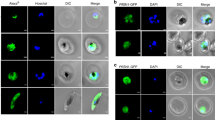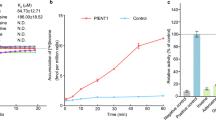Abstract
Thymidylate synthase (TS) of Plasmodium dihydrofolate reductase-thymidylate synthase (DHFR-TS) functions as a homodimeric enzyme with two active sites located near the subunit interface. The dimerization is essential for catalysis, since the active site of each subunit contains amino acid residues contributed from the other TS domain. In P. falciparum DHFR-TS, it has been shown that the active sites require Cys-490 from one domain and Arg-470 donated from the other domain. Mutants of these two series can complement one another giving rise to active enzyme. Here, the potential to form cross-species heterodimers between P. falciparum and P. vivax TS has been explored. Formation of cross-species heterodimer was tested by co-transformation of TS-inactive Cys-490 mutants of P. falciparum or P. vivax with corresponding TS-inactive Arg-486 mutants of P. vivax or P. falciparum into thymidine-requiring Escherichia coli. Active heterodimers were detected by subunit complementation and 6-[3H]-FdUMP binding assays. All combinations of the mutants tested, except for (Pf)R470A+(Pv)C506Y, were able to form catalytically active cross-species heterodimers. The single active site formed by (Pf)R470D+(Pv)C506Y and (Pv)R486D+(Pf)C490A pairs of cross-species heterodimers has k cat and K m values similar to those of intra-species heterodimers of P. falciparum and P. vivax. This is the first report to demonstrate that the TS subunit interface between Plasmodium species is sufficiently conserved to allow formation of fully active cross-species heterodimer.


Similar content being viewed by others
References
Mendis K, Sina BJ, Marchesini P, Carter R (2001) The neglected burden of Plasmodium vivax malaria. Am J Trop Med Hyg 64:97–106
Sina B (2002) Focus on Plasmodium vivax. Trends Parasitol 18:287–289
Price RN, Tjitra E, Guerra CA, Yeung S, White NJ, Anstey NM (2007) Vivax malaria: neglected and not benign. Am J Trop Med Hyg 77:79–87
Yuthavong Y (2002) Basis for antifolate action and resistance in malaria. Microbes Infect 4:175–182
Hitching GH (1960) Pyrimethamine-use of an antimetabolite in the chemotherapy of malaria and other infections. Clin Pharmacol Ther 1:570–589
Olliaro PL, Yuthavong Y (1999) An overview of chemotherapeutic targets for antimalarial drug discovery. Pharmacol Ther 81:91–110
Macreadie I, Ginsburg H, Sirawaraporn W, Tilley L (2000) Antimalarial drug development and new targets. Parasitol Today 16:438–444
Carreras CW, Santi DV (1995) The catalytic mechanism and structure of thymidylate synthase. Annu Rev Biochem 64:721–762
Tjitra E, Baker J, Suprianto S, Cheng Q, Anstey NM (2002) Therapeutic efficacies of artesunate–sulfadoxine–pyrimethamine and chloroquine–sulfadoxine–pyrimethamine in vivax malaria pilot studies: relationship to Plasmodium vivax dhfr mutations. Antimicrob Agents Chemother 46:3947–3953
Houghton PJ, Germain GS, Hazelton BJ, Pennington JW, Houghton JA (1989) Mutants of human colon adenocarcinoma, selected for thymidylate synthase deficiency. Proc Natl Acad Sci USA 86:1377–1381
Ingraham HA, Dickey L, Goulian M (1986) DNA fragmentation and cytotoxicity from increased cellular deoxyuridylate. Biochemistry 25:3225–3230
Yoshioka A, Tanaka S, Hiraoka O, Koyama Y, Hirota Y, Ayusawa D, Seno T, Garrett C, Wataya Y (1987) Deoxyribonucleoside triphosphate imbalance. 5-Fluorodeoxyuridine-induced DNA double strand breaks in mouse FM3A cells and the mechanism of cell death. J Biol Chem 262:8235–8241
Rathod PK, Reshmi S (1994) Susceptibility of Plasmodium falciparum to a combination of thymidine and ICI D1694, a quinazoline antifolate directed at thymidylate synthase. Antimicrob Agents Chemother 38:476–480
Hekmat-Nejad M, Rathod PK (1996) Kinetics of Plasmodium falciparum thymidylate synthase: interactions with high-affinity metabolites of 5-fluoroorotate and D1694. Antimicrob Agents Chemother 40:1628–1632
Jiang L, Lee PC, White J, Rathod PK (2000) Potent and selective activity of a combination of thymidine and 1843U89, a folate-based thymidylate synthase inhibitor, against Plasmodium falciparum. Antimicrob Agents Chemother 44:1047–1050
Muregi FW, Kano S, Kino H, Ishih A (2009) Plasmodium berghei: efficacy of 5-fluoroorotate in combination with commonly used antimalarial drugs in a mouse model. Exp Parasitol 121:376–380
Yuvaniyama J, Chitnumsub P, Kamchonwongpaisan S, Vanichtanankul J, Sirawaraporn W, Taylor P, Walkinshaw MD, Yuthavong Y (2003) Insights into antifolate resistance from malarial DHFR-TS structures. Nat Struct Biol 10:357–365
Hardy LW, Finer-Moore JS, Montfort WR, Jones MO, Santi DV, Stroud RM (1987) Atomic structure of thymidylate synthase: target for rational drug design. Science 235:448–455
Montfort WR, Perry KM, Fauman EB, Finer-Moore JS, Maley GF, Hardy L, Maley F, Stroud RM (1990) Structure, multiple site binding, and segmental accommodation in thymidylate synthase on binding dUMP and an anti-folate. Biochemistry 29:6964–6977
Schiffer CA, Clifton IJ, Davisson VJ, Santi DV, Stroud RM (1995) Crystal structure of human thymidylate synthase: a structural mechanism for guiding substrates into the active site. Biochemistry 34:16279–16287
Finer-Moore JS, Montfort WR, Stroud RM (1990) Pairwise specificity and sequential binding in enzyme catalysis: thymidylate synthase. Biochemistry 29:6977–6986
Perry KM, Fauman EB, Finer-Moore JS, Montfort WR, Maley GF, Maley F, Stroud RM (1990) Plastic adaptation toward mutations in proteins: structural comparison of thymidylate synthases. Proteins 8:315–333
Bawankar P, Shaw PJ, Sardana R, Babar PH, Patankar S (2010) 5′ and 3′ end modifications of spliceosomal RNAs in Plasmodium falciparum. Mol Biol Rep 37:2125–2133
Leartsakulpanich U, Imwong M, Pukrittayakamee S, White NJ, Snounou G, Sirawaraporn W, Yuthavong Y (2002) Molecular characterization of dihydrofolate reductase in relation to antifolate resistance in Plasmodium vivax. Mol Biochem Parasitol 119:63–73
McKie JH (1994) Homology modelling of the dihydrofolate reductase-thymidylate synthase bifunctional enzyme of Leishmania major, a potential target for rational drug design in leishmaniasis. Drug Des Discov 11:269–288
Reche P, Arrebola R, Olmo A, Santi DV, Gonzalez-Pacanowska D, Ruiz-Perez LM (1994) Cloning and expression of the dihydrofolate reductase-thymidylate synthase gene from Trypanosoma cruzi. Mol Biochem Parasitol 65:247–258
Trujillo M, Donald RG, Roos DS, Greene PJ, Santi DV (1996) Heterologous expression and characterization of the bifunctional dihydrofolate reductase-thymidylate synthase enzyme of Toxoplasma gondii. Biochemistry 35:6366–6374
O’Neil RH, Lilien RH, Donald BR, Stroud RM, Anderson AC (2003) The crystal structure of dihydrofolate reductase-thymidylate synthase from Cryptosporidium hominis reveals a novel architecture for the bifunctional enzyme. J Eukaryot Microbiol 50(Suppl):555–556
Sirawaraporn W, Prapunwattana P, Sirawaraporn R, Yuthavong Y, Santi DV (1993) The dihydrofolate reductase domain of Plasmodium falciparum thymidylate synthase-dihydrofolate reductase. Gene synthesis, expression, and anti-folate-resistant mutants. J Biol Chem 268:21637–21644
Shallom S, Zhang K, Jiang L, Rathod PK (1999) Essential protein–protein interactions between Plasmodium falciparum thymidylate synthase and dihydrofolate reductase domains. J Biol Chem 274:37781–37786
Wattanarangsan J, Chusacultanachai S, Yuvaniyama J, Kamchonwongpaisan S, Yuthavong Y (2003) Effect of N-terminal truncation of Plasmodium falciparum dihydrofolate reductase on dihydrofolate reductase and thymidylate synthase activity. Mol Biochem Parasitol 126:97–102
Pookanjanatavip M, Yuthavong Y, Greene PJ, Santi DV (1992) Subunit complementation of thymidylate synthase. Biochemistry 31:10303–10309
Chanama M, Chitnumsub P, Yuthavong Y (2005) Subunit complementation of thymidylate synthase in Plasmodium falciparum bifunctional dihydrofolate reductase-thymidylate synthase. Mol Biochem Parasitol 139:83–90
Chitnumsub P, Yuvaniyama J, Vanichtanankul J, Kamchonwongpaisan S, Walkinshaw MD, Yuthavong Y (2004) Characterization, crystallization and preliminary X-ray analysis of bifunctional dihydrofolate reductase-thymidylate synthase from Plasmodium falciparum. Acta Crystallogr D 60:780–783
Bradford MM (1976) A rapid and sensitive method for the quantitation of microgram quantities of protein utilizing the principle of protein-dye binding. Anal Biochem 72:248–254
Meek TD, Garvey EP, Santi DV (1985) Purification and characterization of the bifunctional thymidylate synthetase-dihydrofolate reductase from methotrexate-resistant Leishmania tropica. Biochemistry 24:678–686
Segel IH (1975) Enzyme kinetics: behavior and analysis of rapid equilibrium and steady-state enzyme systems. Wiley-Interscience, New York
Santi DV, McHenry CS (1972) 5-Fluoro-2′-deoxyuridylate: covalent complex with thymidylate synthetase. Proc Natl Acad Sci USA 69:1855–1857
Matthews DA, Appelt K, Oatley SJ (1989) Stacked beta-bulges in thymidylate synthase account for a novel right-handed rotation between opposing beta-sheets. J Mol Biol 205:449–454
Dasgupta T, Anderson KS (2008) Probing the role of parasite-specific, distant structural regions on communication and catalysis in the bifunctional thymidylate synthase-dihydrofolate reductase from Plasmodium falciparum. Biochemistry 47:1336–1345
O’Neil RH, Lilien RH, Donald BR, Stroud RM, Anderson AC (2003) Phylogenetic classification of protozoa based on the structure of the linker domain in the bifunctional enzyme, dihydrofolate reductase-thymidylate synthase. J Biol Chem 278:52980–52987
Senkovich O, Schormann N, Chattopadhyay D (2009) Structures of dihydrofolate reductase-thymidylate synthase of Trypanosoma cruzi in the folate-free state and in complex with two antifolate drugs, trimetrexate and methotrexate. Acta Crystallogr D 65:704–716
Acknowledgements
This research was supported by the National Center for Genetic Engineering and Biotechnology Grant (BT-B-01-MG-14-4913). This study was partially supported for publication by the China Medical Board (CMB), Faculty of Public Health, Mahidol University, Bangkok, Thailand.
Author information
Authors and Affiliations
Corresponding author
Electronic supplementary material
Below is the link to the electronic supplementary material.
Rights and permissions
About this article
Cite this article
Chanama, M., Chanama, S., Shaw, P.J. et al. Formation of catalytically active cross-species heterodimers of thymidylate synthase from Plasmodium falciparum and Plasmodium vivax . Mol Biol Rep 38, 1029–1037 (2011). https://doi.org/10.1007/s11033-010-0199-7
Received:
Accepted:
Published:
Issue Date:
DOI: https://doi.org/10.1007/s11033-010-0199-7




